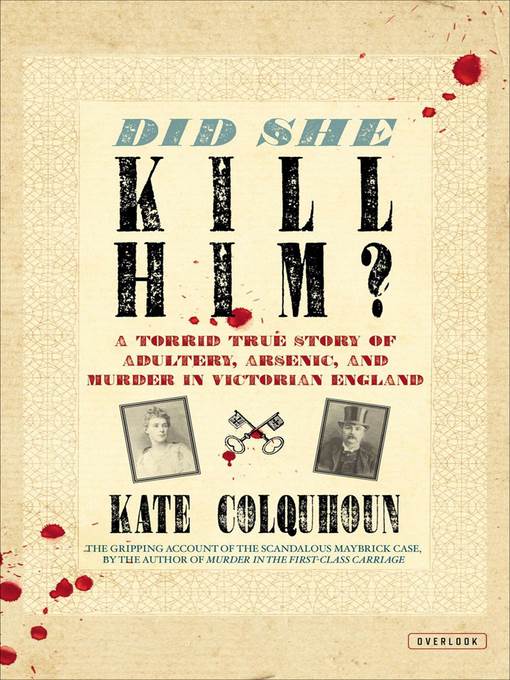
Did She Kill Him?
A Torrid True Story of Adultery, Arsenic, and Murder in Victorian England
کتاب های مرتبط
- اطلاعات
- نقد و بررسی
- دیدگاه کاربران
نقد و بررسی

August 25, 2014
Colquhoun (Murder in the First-Class Carriage) has once again written a phenomenal and nuanced historical true crime account, this time focusing on the notorious 1889 death of Liverpool cotton merchant James Maybrick and the subsequent trial of his American wife, Florence, for his murder. Maybrick had been in poor health for several weeks at the time of his death; Florence, who was carrying on an affair, stood to lose out if a change to her husband’s will went into effect. She became the natural suspect when evidence emerged that he might have died of poisoning. Colquhoun is evenhanded in her presentation of the arguments for and against Florence’s guilt, and places the mystery in context, demonstrating how many deemed her responsible just because of her marital infidelity. The author’s evocative prose is the icing on the cake: “Under the surface of thrusting progress, beneath the skin of propriety and manners, vicious poverty, a violent gang culture, and physical suffering persisted.” The result is an enthralling page-turner that will attract fans of true crime and Victorian England. Agent: Caroline Dawnay, United Agents (U.K.).

September 15, 2014
The mystery of what happened in the summer of 1889 "beneath the skin of propriety and manners" at a British mansion. In this true story that created headlines in both the U.K. and the United States, Colquhoun (Murder in the First-Class Carriage: The First Victorian Railway Killing, 2011, etc.) fulsomely describes the privileged lives of Liverpool's high society in Victorian England and introduces the principals as less than virtuous: Florence Maybrick was "vain, impatient and tiresomely self-absorbed as a spoiled child," and her wealthy husband, James, "turned out to be faithless and morose." Yet with these flawed, mostly unsympathetic characters, the author tells an engrossing story. James habitually consumed nostrums and tinctures containing strychnine, hydrochloric acid and arsenic (not uncommon in the late 1880s) and regularly used arsenic as a "general prophylactic against disease." However, when he died suspiciously two years after marrying Florence, the question became, did his wife, nearly 25 years his junior, poison him, or was his self-medication the cause? Colquhoun presents comprehensive-to a fault-accounts of all the legal proceedings using court transcriptions and newspaper accounts, and she devotes dozens of pages to courtroom testimony from doctors, nurses and coroners about the amount of arsenic they could only guess was in James' body at the time of his death. (The two-page list of characters at the end should help readers who become confused.) Though Colquhoun focuses closely on her story, some readers, drawn into the narrative, may draw parallels from this "Maybrick mania" to the current coverage of sensational cases. Throughout the narrative, the author makes use of a variety of antiquated words and phrases, none more delightful than her description of the "tatterdemalion viragoes" outside the courthouse "hiss[ing] their opprobrium." An intriguing story told in the style of Thomas Hardy or George Eliot, if they traded in true crime.
COPYRIGHT(2014) Kirkus Reviews, ALL RIGHTS RESERVED.

October 15, 2014
She was young, an American southern belle, nearly beautiful, and seemed to ooze the promise of family wealth. He was quite a bit older, seemed stable, and appeared to be an upstanding cotton merchant across the pond in Liverpool. A marriage made in heaven? Hardly! Infidelities and many hard-learned truths later, husband James Maybrick is dead. Little bottles with traces of arsenic (a popular addition to contemporaneous tonics) are found throughout the house, on the bedside table, and hidden in a suitcase. The murder game is on. Did the petite, cash-strapped wife, Florence Maybrick, murder him? A houseful of servants was watching, but what did these people actually see? The Victorian citizenry and torrid-headline-writing press jumped on the Maybrick Mystery and the scandalous 1889 trial. Award-nominated Colquhoun (Murder in the First-Class Carriage, 2011a Victorian whodunit as well) employs again her fine storytelling sense, eye for detail, and impeccable research to ensure that contemporary readers will snap up this tale of treachery, deceit, love gone awry, poison, and the slipperiness of truth. (Reprinted with permission of Booklist, copyright 2014, American Library Association.)

























دیدگاه کاربران